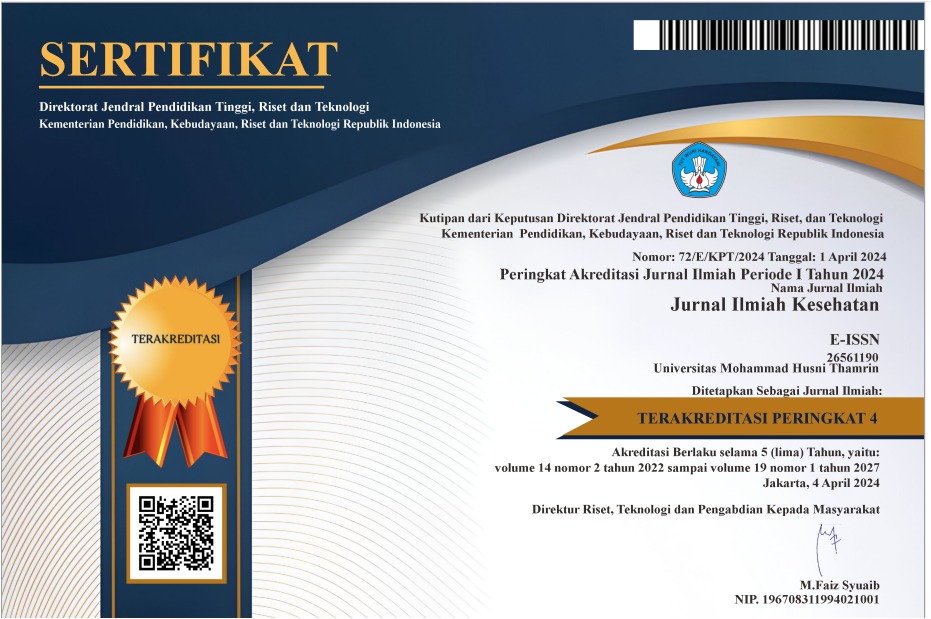Analysis of Stunting Incidents in Depok
Analisis Kejadian Stunting di Depok
DOI:
https://doi.org/10.37012/jik.v17i1.2362Keywords:
Stunting, Balita, DepokAbstract
Indonesia still faces the problem of stunting with a prevalence of above 20%. To achieve the government's target of reducing the prevalence of stunting to 14%, a lot of effort is needed. This research was conducted aimed at analysing the incidence of stunting in Depok because the prevalence of stunting in Depok is still high. This study used qualitative research method by using in-depth interview to 5 informants. The results of this research found that the main causes of stunting are a lack of nutritious food intake and infectious diseases which are influenced by parenting patterns and family socio-economics. To overcome this, the Depok city government is trying to carry out early detection of pregnant women with chronic energy deficiency (CED), anaemia and providing additional food for pregnant women with CED. Academics routinely hold advocacy and provide policy and program recommendations from research conducted, so that it is based on studies conducted in Indonesia and the world.
Keywords : Stunting, Toddlers, Depok
References
Akseer, N., Tasic, H., Nnachebe Onah, M., Wigle, J., Rajakumar, R., Sanchez-Hernandez, D., Akuoku, J., Black, R.E., Horta, B.L., Nwuneli, N., Shine, R., Wazny, K., Japra, N., Shekar, M., Hoddinott, J., 2022. Economic costs of childhood stunting to the private sector in low- and middle-income countries. eClinicalMedicine 45, 101320. https://doi.org/10.1016/j.eclinm.2022.101320
Balitbangkes. Laporan_Nasional_Riskesdas 2018 [Internet]. Badan Penelitian dan Pengembangan Kesehatan. 2018. p. 198. Available from: http://labdata.litbang.kemkes.go.id/images/download/laporan/RKD/2018/Laporan_Nasional_RKD2018_FINAL.pdf
Dewey, K.G., Begum, K., 2011. Long-term consequences of stunting in early life: Long-term consequences of stunting. Maternal & Child Nutrition 7, 5–18. https://doi.org/10.1111/j.1740-8709.2011.00349.x
Hanifah L, Wulansari R, Meiandayati R, Laksminingsih E. Stunting trends and associated factors among Indonesian children aged 0-23 months: Evidence from Indonesian Family Life Surveys (IFLS) 2000, 2007 and 2014. 2018;24(3):315–22.
Junadi P. Dinamika Kabupaten/Kota dalam Implementasi Percepatan Penurunan Stunting (P2S) di Indonesia. Jakarta; 2021.
Kementerian Kesehatan Indonesia, 2020. Peraturan Menteri Kesehatan Nomor 2 Tahun 2020 tentang Standar Antropometri Anak
Kementerian Kesehatan RI. (2022). Kementerian Kesehatan Rilis Hasil Survei Status Gizi Indonesia (SSGI) tahun 2022. Https://Upk.Kemkes.Go.Id/New/Kementerian-Kesehatan-Rilis-Hasil-Survei-Status-Gizi-Indonesia-Ssgi-Tahun-2022.
Khayati, F. N., Agustiningrum, R., Kusumaningrum, P. R., & Hapsari, F. P. (2020). Analysis of Factors That Influence Stunting On Toddlers. 27(ICoSHEET 2019), 127–130. https://doi.org/10.2991/ahsr.k.200723.031
Nurmalasari, Y., Anggunan, A., & Febriany, T. W. (2020). Hubungan Hubungan Tingkat Pendidikan Ibu Dan Pendapatan Keluarga Dengan Kejadian Stunting Pada Anak Usia 6-59 Bulantingkat Pendidikan Ibu Dan Pendapatan Keluarga Dengan Kejadian Stunting Pada Anak Usia 6-59 Bulan Di Desa Mataram Ilir Kecamatan Seputih Sur. Jurnal Kebidanan Malahayati, 6(2), 205–211. https://doi.org/10.33024/jkm.v6i2.2409
Pemerintah Indonesia, 2021. Peraturan Presiden (PERPRES) Nomor 72 Tahun 2021 tentang Percepatan Penurunan Stunting.
Pratiwi, S. N. (2023). Faktor-Faktor Yang Berhubungan Dengan Status Gizi Balita Usia 3-5 Tahun. Nutrizone (Nutrition Research and Development Journal, 3(2), 10–21. https://journal.unnes.ac.id/sju/index.php/nutrizione/
Rahman, N., Dewi NU, Fitrasyah, SI., Bohari, Oktaviani, V., Rifai, M. 2017. Factor related to exclusive breastfeeding among mothers of the City of Palu, Central Sulawesi, Indonesia. Mal J Nutr 23(2): 175-189
Rytter, M.J.H., Kolte, L., Briend, A., Friis, H., Christensen, V.B., 2014. The Immune System in Children with Malnutrition—A Systematic Review. PLoS ONE 9, e105017. https://doi.org/10.1371/journal.pone.0105017
Simanjorang, C., Hanifah, L., Togatorop, L. B., Lestari, M. R., Zahra, A. S. A., & Wangsawinangun, R. Z. R. (2024). Faktor-Faktor yang Berhubungan dengan Kejadian Stunting di Kota Sukabumi. Malahayati Nursing Journal, 6(3), 1121–1133. https://doi.org/10.33024/mnj.v6i3.12897
UNICEF. Improving Child Nutrition. Vol. 18, NCSL legisbrief. 2013. 1–2 p.
World Health Organization, 2018. Reducing stunting in children: equity considerations for achieving the global nutrition targets 2025. World Health Organization, Geneva.
Downloads
Published
How to Cite
Issue
Section
Citation Check
License
Copyright (c) 2025 Laily Hanifah

This work is licensed under a Creative Commons Attribution 4.0 International License.
Jurnal Ilmiah Kesehatan allows readers to read, download, copy, distribute, print, search, or link to the full texts of its articles and allow readers to use them for any other lawful purpose. The journal allows the author(s) to hold the copyright without restrictions. Finally, the journal allows the author(s) to retain publishing rights without restrictions Authors are allowed to archive their submitted article in an open access repository Authors are allowed to archive the final published article in an open access repository with an acknowledgment of its initial publication in this journal.

Lisensi Creative Commons Atribusi 4.0 Internasional.










